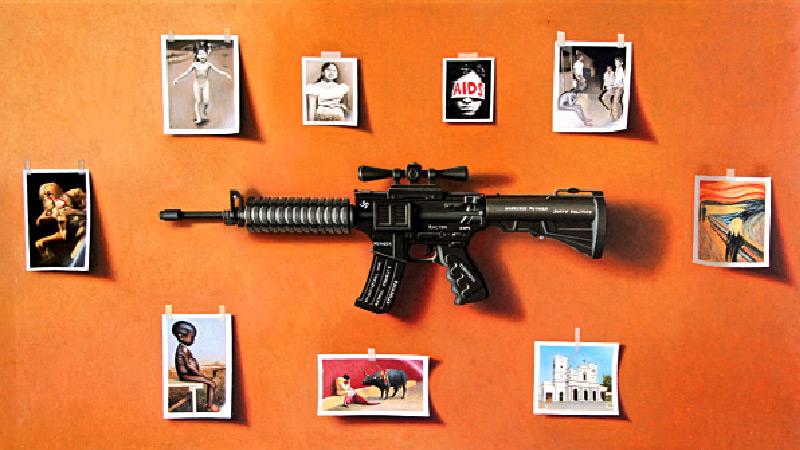
Stains of tales unfold, an art exhibition by award winning artist Anupa Perera will be held at the Lionel Wendt Gallery from April 1 to 3, 2022.

Once in a while, hidden among the rubble of mundane and ridiculous Facebook posts, I come across the breathtaking beauty of a glistening gem. Paintings by Anupa Perera are such rare gems. Anupa’s paintings do not appear frequently on Facebook. When they do, they grab attention and make the viewer stop scrolling and stare for a while. That is not an easy feat for an artist nowadays, given the extent of visual bombardment via social media. I too have stopped to stare at Anupa’s paintings which have since then stayed with me stirring my heart and mind. Such is the power of good art.

 The first painting I saw was of a toy battle tank with Picasso’s ‘Guernica’ pinned to a wall in the background. I was intrigued and decided to speak with the artist to discover more. “I’ve titled it ‘Guernica is not the Final Painting’. Picasso painted Guernica to portray his frustration, misery, anger about war and violence. But it didn’t end with Picasso. It’s ongoing, even now. War is a game for the powerful. They play with millions of lives as if they are playing with toys. That’s what I wanted to symbolise with the toy battle tank.” Anupa said. There was something calm and philosophical about him, so I probed further.
The first painting I saw was of a toy battle tank with Picasso’s ‘Guernica’ pinned to a wall in the background. I was intrigued and decided to speak with the artist to discover more. “I’ve titled it ‘Guernica is not the Final Painting’. Picasso painted Guernica to portray his frustration, misery, anger about war and violence. But it didn’t end with Picasso. It’s ongoing, even now. War is a game for the powerful. They play with millions of lives as if they are playing with toys. That’s what I wanted to symbolise with the toy battle tank.” Anupa said. There was something calm and philosophical about him, so I probed further.
Anupa graduated from the University of Visual and Performing Arts, Colombo. His chosen forte has always been Hyper Realistic Painting. After graduation, like most others, he had looked for a job in Colombo but to no avail. As the career opportunities were limited, he had accepted a government teaching position.
First assignment
“I didn’t think I would enjoy teaching. The pension and the relative freedom compelled me” he was honest enough to admit. “My first assignment was to a remote school in the Maha Wilachchiya area in the Anuradhapura district. Initially, I was apprehensive and thought I could get a transfer after two years. After a while I realised that I have found my place and my calling in life. Most of the students are from the farming community. Theirs is not an easy life. Yet the staff, parents and students are such wonderful people I feel it is my home now. This is a very quiet life and I get to work on my own practice while developing the skills of my students. I have no intention of going back to Colombo,” he said.
Anupa is an exception. Most who become art teachers cease to be artists and for most, teaching is a just a job. Anupa has proven otherwise. He is passionate about developing his students. “I try to give them all that I know. There is an A/L student whose skill level is equal to mine. I organise exhibitions at the school and have even brought them to the annual Kala Pola in Colombo.
“Most of my students come from farming families. They face many difficulties, economically and otherwise but I believe I could make a positive difference in their lives,” he added.
There were two other portraits which drew my attention. Both were of young girls who are Anupa’s students. In one the model is in a uniform wearing a jakfruit leaf crown which symbolises the dreams and aspirations of a village girl. The other which Anupa has titled ‘Modern Monalisa’ has an image of Banksy’s famous ‘Monalisa with a missile launcher’ pinned to the wall symbolising the contextual differences of femininity between Da Vinci’s Mona Lisa and the current woman.
Anupa’s art is rich with symbolism and it is apparent to the audience that the artist is trying to say something more than what meets the eye. That is where he differs from the usual contemporary hyper realistic trend. Anupa tries to present in-depth meaning to issues which are grounded here and now yet exceeds boundaries of time and space. His art goes beyond superficial beauty.
Performance and capability
‘When it comes to academic and extra-curricular performance and capability these girls (represented by the models) are equal and at times even better than the boys.
However, in a patriarchal society their potential is curtailed. In the remote village in which I live, most women end up going abroad as domestic workers. I want my paintings to capture their lives, their grievances and difficulties so that at least a few (who view my art) would be aware of the kind of lives people live in remote areas in this country,” he said.
Finally, I asked Anupa what his aspirations are as an artist. “I am quite content with my life. I would like to hold a solo exhibition one day, but am not in a hurry. I take about a month to finish a painting. I just want to enjoy the process.”
